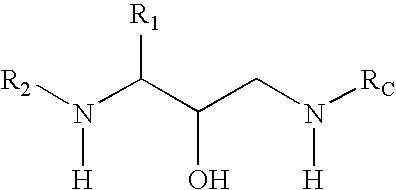Methods of treatment of amyloidosis using bi-aryl aspartyl protease inhibitors
a technology of protease inhibitors and amyloidosis, which is applied in the field of amyloidosis treatment using biaryl aspartyl protease inhibitors, can solve the problems of unsuitable compounds, unfavorable treatment, and inability of known aspartyl protease inhibitors to cross the blood-brain barrier or great difficulty, so as to improve the ability to cause, prevent or treat the targeted diseases or conditions, the effect of increasing the ability
- Summary
- Abstract
- Description
- Claims
- Application Information
AI Technical Summary
Benefits of technology
Problems solved by technology
Method used
Image
Examples
example 1
GENERAL PREPARATION OF BIARYL BETA-SECRETASE INHIBITOR USING SCHEME 2
[0244]
[0245] Suitable acids for use in deprotection (see steps 7 and 8) include trifluoroacetic acid in CH2Cl2 and 4 N HCl in ether or dioxane. Suitable acetylating reagents include, for example, acetylimidazole, diacetylmethoxylamine (Kikugawa, Y. et al. Tetrahedron Lett., 1990, 31, 243-246), and acetic acid / 1-hydroxybenzotriazole / 1-(3-dimethylaminopropyl)-3-ethylcarbodiimide.
example 2
GENERAL PREPARATION OF BIARYL BETA-SECRETASE INHIBITORS USING SCHEME 1
[0246]
[0247] The Negishi coupling (see step 2) may be performed with 1.5-5 equivalents of alkylzinc halide (e.g., chloride, bromide, or iodide) reagent in ethereal solvent such as diethyl ether or tetrahydrofuran, at room temperature to 70° C. The coupling is facilitated by 2-20 mol % palladium catalyst. Appropriate catalysts include, for example, dichlorobis(triphenylphosphine)palladium(II), dichlorobis(tri-o-tolylphosphine) palladium(II), and [bis(diphenylphosphino)ferrocene]palladium(II) (1:1 complex with CH2Cl2).
[0248] Suitable reduction reagents for step 3 include, for example borane-dimethylsulfide complex, borane-tetrahydrofuran complex, borane-dimethylamine complex, lithium aluminum hydride, and hydrogen gas over palladium on carbon.
[0249] Suitable acids for use in deprotection (see steps 5 and 6) include, for example, trifluoroacetic acid in CH2Cl2 and 4 N HCl in ether or dioxane. Suitable acetylating r...
example 3
PREPARATION OF BIARYL BETA-SECRETASE INHIBITORS USING SCHEME 1
[0250]
[0251] The Negishi coupling (see step 3) may be performed with 1.5-5 equivalents of alkylzinc halide (e.g., chloride, bromide, or iodide) reagent in ethereal solvent such as diethyl ether or tetrahydrofuran, at room temperature to 70° C. The coupling is facilitated by 2-20 mol % palladium catalyst. Appropriate catalysts include, for example dichlorobis(triphenylphosphine)palladium(II), dichlorobis(tri-o-tolylphosphine) palladium(II), and [bis(diphenylphosphino)ferrocene]palladium(II) (1:1 complex with CH2Cl2).
[0252] Suitable reduction reagents for step 6 include, for example, borane-dimethylsulfide complex, borane-tetrahydrofuran complex, borane-dimethylamine complex, lithium aluminum hydride, and hydrogen gas over palladium on carbon.
[0253] Suitable acids for use in deprotection (see steps 8 and 9) include, for example, trifluoroacetic acid in CH2Cl2 and 4 N HCl in ether or dioxane. Suitable acetylating reagents ...
PUM
| Property | Measurement | Unit |
|---|---|---|
| Fraction | aaaaa | aaaaa |
| Dimensionless property | aaaaa | aaaaa |
| Fraction | aaaaa | aaaaa |
Abstract
Description
Claims
Application Information
 Login to View More
Login to View More - R&D
- Intellectual Property
- Life Sciences
- Materials
- Tech Scout
- Unparalleled Data Quality
- Higher Quality Content
- 60% Fewer Hallucinations
Browse by: Latest US Patents, China's latest patents, Technical Efficacy Thesaurus, Application Domain, Technology Topic, Popular Technical Reports.
© 2025 PatSnap. All rights reserved.Legal|Privacy policy|Modern Slavery Act Transparency Statement|Sitemap|About US| Contact US: help@patsnap.com



